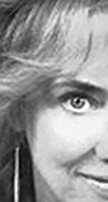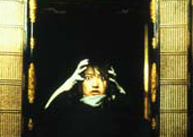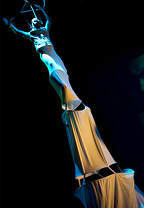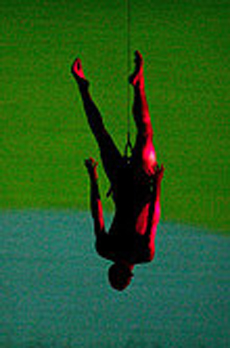
LIVES: Elizabeth Hand, novelist
Omnium exeunt in mysterium: all ends in mystery.
Most of my writing stems from a single intense emotional experience, usually recalled long after the fact; maybe even just from the nuances of a single emotion.
I’m less concerned with plot than I am with creating characters capable of channeling what I felt, so when I work, I try to tap into that emotion again.
I trained as an actor, and the one thing I think I kept from that experience is the ability to immerse myself in a character’s emotional life and recreate it, on the page rather than on the stage.
Laurence Olivier said: “I scavenge for that tiniest little bit of human circumstance. Observe it. Use it.”
That’s what I try to do.
When I’m working, especially in the early stages of developing a character, I’ll listen to music compulsively -- obsessively -- until I hit on a song that evokes that character or the emotional experience associated with her/him.
It’s never the song I was listening to at the time the original event occurred, and it’s not the Soundtrack From My Life, say, fifteen years ago, or five; it’s whatever music makes me feel wistful or furious or exultant right now.
Once I’ve hit on that one note, I’ll just play it over and over while I’m writing or driving around; say, twenty or thirty times a day. Maybe more. It’s like scoring the soundtrack to a film – an individual character will also have a theme, or theme songs. I tend to use popular music rather than classical; “Tristan and Isolde” is a bit beyond my reach, so I wouldn't presume to channel Wagner.
A short story or novella might have one song, or two or three; a novel has an entire soundtrack.
Once I’m finished with any individual work, it can be difficult for me to listen to that piece of music again -- the connections are too intense.
THE DAILY
My writing rituals are pretty much what I described above, listening to the same music obsessively. My routine consists of getting my kids off to school, then getting down to my cottage to write.
If I’m doing my normal day-to-day writing -- i.e., if I’m not writing a particular scene or chapter that’s ‘scored’ by an individual song -- I listen to Nick Drake’s album FIVE LEAVES LEFT (less intense than BRYTER LAYTER) and Paul Westerberg’s FOURTEEN SONGS.
I’ve been listening to these two albums every day for years and years. I set myself a quota of 1,000 words a day. Sometimes I do more than that, rarely less.
I write very intensely, and a lot of the time it’s emotionally draining material, so those five pages can really tap me out.
LIFE, THE DRAMA
Most of what I do is drawn on real events or real people. I’m not good at making stuff up, but I’m pretty good at taking earthbound material and ornamenting it so that it takes on a more resonant, mythic sensibility.
“Waking the Moon” was in many ways the alternate take of certain events in my life, with characters inspired by friends of mine; ditto “Black Light”.
I did a reading from “Mortal Love” several years ago, when it was still a work-in-progress, and people in the audience began to laugh as they recognized various characters, because they knew their real-life counterparts.
As for the major difference between fiction and real life, I’ll quote Richard Thompson on this one --
“Life is just as deadly as it looks,
But fiction is more forgiving.”
LIFE LESSONS
The most startling thing anyone ever said to me was “don’t be a victim”.
This was from my friend O.J., the model for Oliver in “Waking the Moon”. We were in college, I guess about nineteen years old.
He looked at me one night and right out of the blue said, in this really chilling tone, “Don’t be a victim.”
I was very taken aback. I didn't understand what he meant. I hadn’t been behaving particularly melodramatically -- certainly not any more than usual.
We had an intensely close, almost psychic friendship for a few years, but that was so strange, because it seemed out of context, almost like he was making some oracular observation.
But I took his words very seriously, and I’ve always tried to live by them, to take responsibility for my own life, refuse to let someone else dictate the terms by which I succeed or fail.
A few years after O.J. said that to me, I was abducted and raped – I’d been with him just minutes before it happened, and he and my boyfriend were the first people I saw when the police came.
I always wonder if he somehow saw what was going to occur. In the aftermath what got me through was remembering that one phrase: “Don’t be a victim.”
I’ve never forgotten it.
WORDS AND THE MUSE
If I were an album, I’d be the Replacements PLEASED TO MEET ME.
In a more general sense, if I got to pick an alternate artistic arc, I’d probably choose that of Paul Westerberg, former lead singer of the Replacements.
The way his youthful career careened between great, crazed, drunken Fuck You excess, and beautifully disciplined, restrained songs like “Skyway” and “Sadly Beautiful”, and his later Prozac-tinged ballads remind me of the way
I work, and the way I was, once upon a time.
He’s an artist who now faces the realities of middle age, but he’s still able to tap into the energy and rage and exultance that fired his youthful work.
He has an intensity and an integrity that I find genuinely inspiring; his music has been firing me up since about 1987, and I still listen to it about every day. So he’s obviously doing something right.
For a more specific discography, these are the songs or albums I associate with various novels and stories:
WINTERLONG: Love & Rockets, EXPRESS; Replacements, PLEASED TO MEET ME; Strawbs, “Autumn”, from HERO & HEROINE
“Snow on Sugar Mountain”: Phillip Glass, GLASSWORKS
“The Have-Nots”: “Elvis Bought Dora a Cadillac,” Wall of Voodoo
“Snow on Sugar Mountain”: “The Welcome,” Fred Frith (“The Welcome” was the original title for this story)
GLIMMERING: “Pepper,” Butthole Surfers; FOREVER CHANGES, Love; “The Man Who Sold the World”, Nirvana
WAKING THE MOON: “Northern Sky,” Nick Drake; “Ignoreland,” REM; “The Beautiful Ones,” Prince; “She Lives,” John Wesley Harding; “I Have Always Been Here Before,” Roky Erickson
MORTAL LOVE: “20th Century Man,” The Kinks; “Waterloo Sunset,” The Kinks;
“Fade into You,” Mazzy Star; “April Fools,” Rufus Wainwright; “Danny Boy,” Rufus Wainwright; MOCK TUDOR, Richard Thompson; SUMMERTEETH, Wilco
“Chip Crockett’s Christmas Carol”: “Danny Says,” The Ramones; “That Happy Feeling,” Bert Kaemfert & His Orchestra; “Welcome Christmas,” Love Spirals Downwards; “Morning of Our Lives,” Jonathan Richman and the Modern Lovers;
“I Just wasn¹t Made for These Times,” Beach Boys; “Round the Bend,” The Beta Band
BIBLIOMANCY
“Bibliomancy” is a collection of four novellas, so the individual works came first.
I just liked the word.
It’s actually taken a bit out of context -- bibliomancy is an act of divination using the Bible, whereas stichomancy, technically involves divination by the written word.
But “Bibliomancy” scanned better as a title.
WRITERS, AN ODD BREED
John Gardner said the most important thing is for a writer to marry money, or to inherit it.
I agree: the freedom not to have to do something else for a living is critical.
I think discipline is crucial as well. The ability to get up day after day and just do it, knowing you're not going to get paid, or paid enough.
And being well-read -- I teach writing workshops and am consistently amazed by how poorly-read people are -- and these are people who want to be writers!
There’s a Beach Boys song called “Hang on to Your Ego.”
If you don’t have an ego, I suggest you buy or rent one from a reputable source.
You can’t be thin-skinned in this business, and you have to have a very, very strong sense of yourself and the value of what you’re doing. Because you can’t depend on anyone else to value it as much as you do -- not a publisher, or a reader, or an editor.
Ultimately it’s the work itself that has to sustain you. So it had better be good.
There are a few things I wish someone had told me before I started out: that it would be a really good idea to learn how to touchtype.
And that it was going to be a lot more important for writers to look like movie stars -- or to be movie stars -- than any of us ever imagined.
Also, there was one thing that surprised me most about my last book: how long it took for me to write it -- almost five years. And how much I loved writing it.
There was one morning in early 2002 when I realized I was going to finish “Mortal Love” within the next few months (I completed the first, close-to-final draft on July 4, 2002) and it hit me, that I was writing a novel I absolutely loved.
I’d never really had that happen before, except with “Chip Crockett’s Christmas Carol,” which was a very short novel and so no quite as much an investment in time and energy (though “Chip” did took me two years).
Favorite authors: Laurie Colwin, Robert Stone, John Crowley, James Salter, M.John Harrison, T.H. White, Vladimir Nabokov, J.R.R. Tolkien, Hope Mirlees. Shakespeare -- I’m constantly rereading Shakespeare. And I’m currently on a John Fowles kick.
Books I wish I’d written: Too many to list! Laurie Colwin’s “Happy All the Time”, because it’s such a perfect domestic romance. I reread it at least once a year. John Crowley’s “Little, Big”. Shakespeare’s “Twelfth Night.”
On popular culture: "The very first movie I ever saw, when I was about three years old, was Walt Disney’s “Pinocchio”. I cried at the end -- I thought it was so sad that he turned into a real boy. It was so much more interesting to think I lived in a world where puppets could be alive."
Favorite quote from fiction:
“It is all one long day.”
- James Salter, “Light Years”
IN PASSING…
If I meet someone who interests me, I make a point of getting to know him, or her. So, most of the strangers in my life have ended up as friends: “We only truly regret the things we haven't done, not the things we did.”
I did meet Tom Stoppard when I was about nineteen, but I was too shy to say anything much more than “hello.”
I’m trying to think if there’s any marvelous stranger who ever got away...
I don’t think so. Not yet, anyway. There are definitely one or two people out there in the ether I’d like to know better, in realtime. They know who
they are.
MYTHOLOGY
The biggest myth about being a writer is that it’s exciting.
Mickey Spillane said the essence of writing is “Get your ass in a chair. A miserable, lonely life.”
If I wasn’t a writer, I would definitely be: depressed all the time, instead of just in the winter.
No, in my dream life, I’d be a classical archaeologist, studying Mycenaean culture. In real life, I’d probably be a hospice nurse. I’ve worked as a home health aide, living with people who are terminally ill. It’s something I’m good at, and it’s an important job, so I’d probably do that.
Before I die, I’d like to: Continue having an interesting sex life. And have a really big party with everyone I’ve ever known and loved, or even liked, all together at one time in the same place. I’d also like to see Paris. I guess if I had enough money, I could combine all three of these.
##
Author bio: Elizabeth Hand is the author of "Mortal Love" (July 2004), "Bibliomancy” and numerous other works. Her first novel, “Winterlong” was published in 1990, and followed by “Aestival Tide” and “Icarus Descending”.
Contemporary fantasy “Waking the Moon” won the Mythopoeic Society Award. That book was followed by science fantasy “Glimmering” and contemporary fantasy “Black Light”.
Hand’s story collection “Last Summer at Mars Hill” includes the Nebula and World Fantasy award-winning title novella. Among more recent short fiction, "Cleopatra Brimstone" (2001) won the International Horror Guild Award. With longtime friend Paul Witcover, Hand created DC Comics' post-punk, post-feminist cult series “Anima”. She has also written numerous movie and TV novelizations.
More about Elizabeth Hand:
Funniest movie I’ve ever seen: “To Be or Not to Be” (the original, with Jack Benny and Carole Lombard). Or “The Navigator” -- I adore Buster Keaton.
Saddest: The very first movie I ever saw, when I was about three years old, was Walt Disney’s “Pinocchio”. I cried at the end -- I thought it was so sad
that he turned into a real boy. It was so much more interesting to think I lived in a world where puppets could be alive. More recently, I thought “Lost in Translation” was lovely and heartbreaking.
Favorite downtime reading online: The New York Times, The Onion, and The Maine Emergency Management Agency Weather Page, so I can keep up with blizzards.
What I’m reading right now: Rereading “The Collector”, John Fowles
Other interests: I’m an armchair archeologist.
Interesting fact that nobody knows about me yet:
Except for some things which will remain private, anything interesting about me is in my fiction. So everybody knows it already. Or will.
Life is: unutterably mysterious. Omnium exeunt in mysterium: all ends in mystery.
Hand comments on her latest book, "Mortal Love":
"Mortal Love" isn't so much a decadent novel as a Symbolist novel; not a book about the thing but the thing itself. Algernon Swinburne is a supporting character, and really upstages everyone else when he's around. The central female figure is a sort of avatar of the White Goddess; at least that's how mortals see her: her true nature is something else entirely...
This interview is also cached in the June 2004 archives of the "Arte Six" site.









